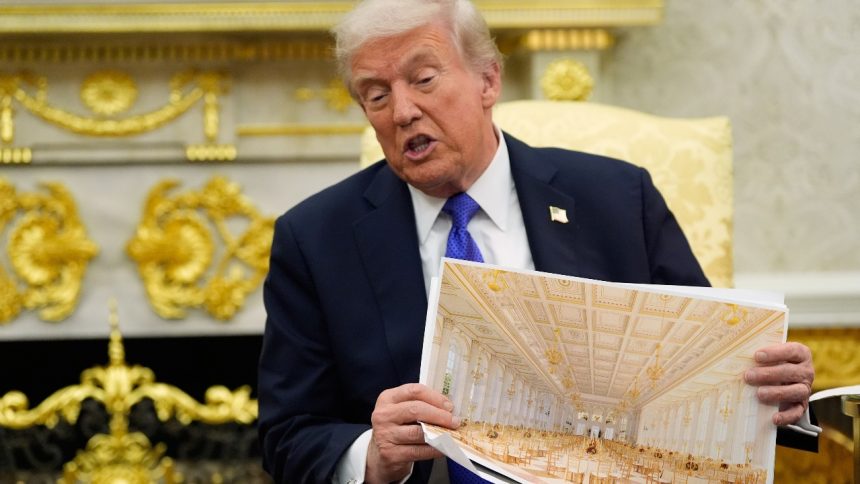When you picture the White House, you probably imagine the iconic Oval Office or the grand State Dining Room. But a massive new project is changing that familiar image: a sprawling 90,000-square-foot ballroom that requires demolishing and rebuilding the entire East Wing. With a price tag soaring past $300 million, a single, burning question dominates the conversation: Who is actually footing the bill for this enormous addition?
The answer is a complex web of private money, political influence, and a firm promise from the White House that this architectural endeavor won’t cost the average American a single dime. This pledge, however, opens up a fascinating and deeply consequential debate about power, perception, and what it means when corporate giants help build a presidential legacy.
You Might Like: The Sad Truth Behind Emman Atienza’s Death
The short and direct answer is that American taxpayers are not directly paying for the construction of the White House ballroom. President Donald Trump has been unequivocal on this point, repeatedly stating that the project is coming at “zero cost to the taxpayer.” Instead of funds being allocated from the federal budget you contribute to with your taxes, the money is flowing from a completely different source.
The financial engine for this project is a collection of deep-pocketed private donors, including some of the most powerful corporations and wealthiest individuals in the country, all coordinated through a special nonprofit trust. This arrangement is the key to understanding the entire situation—it shields the public purse but invites intense scrutiny about the motivations behind such immense private generosity.
The Lineup of Donors Writing the Checks
So, who exactly is on the hook for hundreds of millions of dollars? The White House has released a list of benefactors, and it reads like a guest list for the most exclusive power summit on Earth. We are talking about tech titans like Google, Amazon, Apple, and Microsoft. The defense industry is represented by massive pledges from companies like Lockheed Martin. Even the volatile world of cryptocurrency has thrown its hat in the ring, with executives from Coinbase, Ripple, and other digital currency firms contributing substantial sums.
Trump’s ballroom donors include:
-Google, whose CEO thanked Trump for “resolution” of an antitrust case
-Palantir, which has lucrative contracts with ICE
-Blackstone’s Stephen Schwarzman, who would profit from Trump’s regulatory rollbacks for private equity
Pay-to-play.
— Robert Reich (@RBReich) October 21, 2025
We know from legal filings that Google, as part of a legal settlement, is funneling a staggering $22 million into the project on the president’s behalf. Lockheed Martin has publicly committed $10 million, and a construction CEO named Paolo Tiramani donated another $10 million in company stock. As for Donald Trump himself, he has stated he is contributing his own personal funds, though the exact amount remains undisclosed. The common thread here is that every entity writing a check has a significant stake in the policies and regulations crafted by the very government they are helping to build.
The table below organizes some of the prominent donors revealed by the White House:
| Category | Notable Donors |
|---|---|
| Tech & Telecom | Amazon, Apple, Google (Alphabet), Meta (Facebook), Microsoft, T-Mobile, Comcast |
| Cryptocurrency | Coinbase, Ripple, Cameron & Tyler Winklevoss, Charles & Marissa Cascarilla |
| Defense & Contractors | Lockheed Martin, Booz Allen Hamilton, Palantir Technologies |
| Wealthy Individuals & Families | Miriam Adelson (Adelson Foundation), Stephen Schwarzman (Blackstone), Harold Hamm (Continental Resources) |
The Murky World of Private Funding and Public Power
All these donations are being managed by a specific organization called the Trust for the National Mall, which is a tax-exempt nonprofit. This setup allows the donations to be legally separated from the government and even makes them tax-deductible for the donors. But this clever financial mechanism is the epicenter of the ethical earthquake surrounding the project.
Think about it for a moment. What does a defense contractor like Lockheed Martin, which relies on billions in government contracts each year, hope to achieve by donating $10 million to a president’s pet project? What about a tech giant like Apple or a crypto firm seeking favorable regulations? Government ethics experts have sounded the alarm, calling this a “pay-to-play” system on a historic scale. While there may be no explicit contract promising a policy favor in return for a donation, the arrangement creates an undeniable atmosphere of implied obligation. The president may feel grateful to these supporters, and those who didn’t donate might worry about being sidelined.
This isn’t about illegal bribes; it’s about the subtle currency of access and goodwill. When a corporation funds a permanent part of the White House, it blurs the line between patriotic donation and a strategic investment in political influence, leaving many to wonder if the true cost of the “free” ballroom is the integrity of the government itself.



